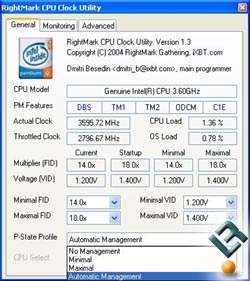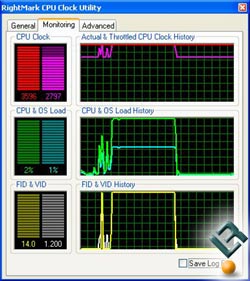Intel 6xx Series Processors Arrive
A Closer Look at C1E Technology
Now that you know that what the new core is all about and you understand what other changes Intel made let’s compare the 5XX series to the 6XX series and the latest Extreme Edition processor. This chart should help the visual learners also as all the data is side-by-side.
|
Pentium 4 5XX |
Pentium 4 6XX |
Pentium 4 Extreme Edition 3.73 GHz |
|
|
Package |
LGA775 |
LGA775 |
LGA775 |
|
Processor rating |
570, 560, 550, 540, 530, 520 |
660, 650, 640, 630 |
None |
|
Clock frequencies |
2.8 ? 3.8 GHz |
3.0 ? 3.6 GHz |
3.73 GHz |
|
Bus frequency |
800 MHz |
800 MHz |
1066 MHz |
|
Core |
Prescott |
Prescott 2M |
Prescott 2M |
|
Manufacturing technology |
90nm, strained silicon |
90nm, strained silicon |
90nm, strained silicon |
|
L1 data cache |
16 KB |
16 KB |
16 KB |
|
Trace cache |
12000 micro-ops |
12000 micro-ops |
12000 micro-ops |
|
L2 cache |
1024 KB |
2048 KB |
2048 KB |
|
EM64T |
None |
Yes |
Yes |
|
XD-bit |
Yes |
Yes |
Yes |
|
EIST |
None |
Yes |
None |
|
Hyper-Threading technology |
Yes |
Yes |
Yes |
|
SIMD-instructions support |
SSE, SSE2, SSE3 |
SSE, SSE2, SSE3 |
SSE, SSE2, SSE3 |
|
Number of transistors |
125 mln |
169 mln |
169 mln |
|
Die size |
112 sq.mm |
135 sq.mm |
135 sq.mm |
Let’s take a look at the new C1E functionality that can be found on the new Intel Pentium 4 660 processor.
After installing the new CPU’s into our ABIT Fatal1ty AA8XE test board we noticed some new lines of text while our system was powering up. It looks like the public BIOS revision that ABIT has out for the Fatal1ty board supports both C1E and can at least detect that our processor is EM64T enabled!

Since most people don’t know what C1E is now would be a great time to take a closer look.
C1E: Enhanced Halt State Technology
The first line in the bios that you may not know is C1E or as most know it Enhanced Halt State. This is when a processor can dynamically reduce the motherboard frequency multiplier (FID) and voltage (VID) yet also restore to the original performance state (nominal FID/VID) when necessary. This is all done automatically if you have the right software. Using C1E requires a motherboard with a suitable BIOS version, and an operating system supporting the feature, such as Windows XP w/SP2. C1E was first seen on the Intel 570J and has been proven more efficient than the older halt mode technology. On the Intel 660 processor we noted that roughly 20W was all the power the CPU needed in idle mode. The C1E feature is available on all the newest Socket 775 Pentium 4 processors, but we were told that over time it should cover the entire Socket 775 family.
|
|
|
Since C1E is something that goes un-noticed we downloaded RightMark CPU Clock Utility 1.3, which is a nice little utility that allows you to monitor and control what your processor is doing. On our Intel 660 procesor we were able to set the FID (frequency multiplier) from 14-18x and the VID (voltage) from 1.2 to 1.4V. We then set our profile to run automatic management and ran some benchmarks. It was noted that our Intel Pentium 4 660 idled at 2.8GHz (14×200 @ 1.2Volts) and under load it went back to the maximal performance settings for 3.6GHz (18×200 @ 1.4Volts).
From our testing thus far it looks like C1E is an improvement over the previous C1 method. As an enthusiast I’d more than happily take any improvements that help to lower the power consumption and reduce the heat on the Prescott cores! From our understanding all processors with J and 3 steppings should offer C1E.



Comments are closed.